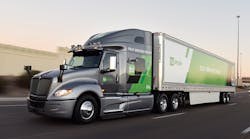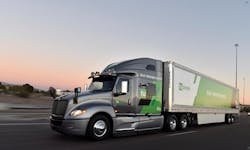TuSimple Completes Self-Driving Truck Test for the USPS
TuSimple, a startup self-driving truck company, has successfully completed a two-week pilot program of five round trips hauling United States Postal Service (USPS) letters and packages more than 1,000 miles between the Postal Service’s Phoenix, Arizona and Dallas, Texas distribution centers. All deliveries were made ahead of schedule and without any traffic incidents, according to TuSimple.
The route from Phoenix to Dallas typically takes a human driver about 48 hours to complete, including stops for rest. Autonomous trucking could cut down on that time considerably. TuSimple ran its self-driving trucks for 22 hours each, which included overnight driving along the Interstate 10, 20, and 30 corridors to make the trip through Arizona, New Mexico, and Texas. Long-haul routes with short turnaround times, such as this journey, are normally accomplished with driving teams of two.
The autonomous trucks involved had a safety engineer and driver on board throughout the test to monitor vehicle performance and ensure public safety. TuSimple co-founder and Chief Technology Officer Dr. Xiaodi Hou wants to start making runs without a driver in 2020, which is the next step in commercializing an autonomous system for the $700 billion trucking market.
TuSimple’s self-driving trucks completed five round trips between Phoenix and Dallas.
TuSimple has 15 Peterbilt and Navistar trucks in its autonomous fleet, all powered by Cummins engines. The company plans to increase its U.S. fleet to 50 trucks. The cost of these trucks has been estimated to be north of $200,000 each, which includes about $150,000 for the vehicle itself and the remainder for its nine cameras, two LiDAR sensors for 3D imaging, forward radar, and an onboard computer from Nvidia.
Camera System
TuSimple has developed a proprietary automotive-grade camera and vision system scheduled to go into volume production during this calendar quarter, and deploy on its autonomous customer fleet by Q3 of 2019. It features Sony Semiconductor’s automotive CMOS image sensor to create a set of camera systems for short, medium, and long -range use. Each system employs TuSimple's software to detect and process images in real-time from as far as 1,000 meters away.
The camera system addresses complex imaging challenges such as instant light changes when entering and exiting tunnels, as well as the headlight glare of oncoming vehicles and the LED flicker created by digital signage and traffic lights. On top of that, the system allows for night and low-light autonomous operation plus operation during sunrise and sunset.
"Like human drivers, autonomous trucks' perception systems are challenged by a wide variety of light conditions which are experienced every day while driving. We weren't able to find a camera system on the market that fit our needs, so we created one," says Dr. Hou, "The combined expertise of Sony Semiconductor Solutions Corporation and TuSimple has created a perception system that sees better than the human eye—night and day, rain or shine—in the most challenging driving conditions."
This new camera system is designed to Automotive Safety Integrity Level (ASIL)-C as outlined in the ISO 26262 Functional Safety standard. System integrator Sunny Optical will test the product and module, as well as develop and manufacture the automotive-grade product.
Adding nighttime operation will enable fleets to increase truck utilization from an average of 50%, or 12 hours per day, to an average of over 80%, according to TuSimple.
"Bringing reliable nighttime and low-light operation to current perception systems in the market is an important step in the viability of autonomous driving, which is a strategic focus for us," says Tsutomu Haruta, Automotive Business Division Deputy SGM, Sony Semiconductor Solutions Corporation.
USPS is currently looking to replace its aging fleet of vehicles, but projects that vehicle replacement will cost more than $800 million per year for 10 years. Overall, according to a 2018 Government Accountability Report, the service is facing the prospect of having to increase spending 70% over the next decade to cover costs.
As such, the postal service is exploring the feasibility of utilizing autonomous-delivery-vehicle technology to improve its fleet utilization rate through longer hours of operation. Self-driving trucks could save millions by eliminating human drivers as well as render irrelevant the rest mandates that keep them from driving around the clock (regulations limit truckers to 11 hours at a stretch).
TuSimple is taking advantage of the relatively simpler task of navigating interstate highways rather than congested city streets. “It is exciting to think that before many people will ride in a robo-taxi, their mail and packages may be carried in a self-driving truck,” says Dr. Hou. “Performing for the USPS in this particular commercial corridor gives us specific use cases to help us validate our system and expedite the technological development and commercialization progress.”


